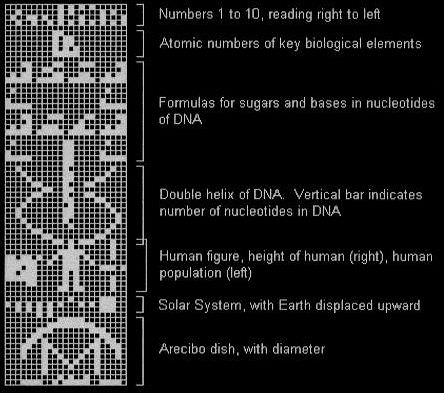[/caption]
It’s about fifty years since Frank Drake sent out our first chat request to the wider universe. I say about as I think the official date is 11 April 1960 – but I notice a lot of fifty year anniversary blogs and interviews are already being published, so what the heck, I’m not waiting either.
While no-one is really concerned that we haven’t had an answer back yet, it is a little despondent to have scanned the skies for someone else’s chat request all this time and found nothing.
In a recent New Scientist interview (actually January 2010 – they were really getting in early), Drake refers to his equation delivering an answer in the order of one in 10 million stars having an advanced civilization – and he uses that statistic to indicate it’s too early to think we have done a statistically adequate scan yet.
Nonetheless, the chances of there being advanced civilizations near enough to enable a future United Federation of Planets already looks doubtful.
Drake’s initial communication efforts in Project Ozma were small scale, but his clever and carefully constructed Arecibo message out to Messier 13 (a globular cluster of approximately 300,000 stars) in 1974 aroused some criticism that telling the aliens where we are might result in an invasion.
This is a little implausible, since Messier 13 is 25,000 light years away. By the time the invasion fleet arrives we will either be long gone or have spent the intervening period developing the technology to blast them out of the sky if they don’t turn back immediately.
Actually, that’s probably an important consideration if we ever decide to invade someone. We will need to take a couple of universities along to keep our technology advancing ahead of theirs. However, if we are travelling near the speed of light, the time differential means that they will get ahead anyway. Hmm…

Anyway, here in the 21st century, I want to suggest that more attention should be given to us just not looking stupid. There’s already all the bad TV out there. We can fairly claim that all that was never meant for alien consumption, but recently we advanced humans have quite deliberately transmitted a Beatles song to Polaris and sent a bunch of text messages to Gliese 581. I mean, huh?
Polaris, being a Cepheid variable – and in any case a short-lived and already dying supergiant – was probably never stable enough to support planets, so we probably got away with that one. However, there’s no getting around us sending text messages to Gliese 581c in 2008 (from Ukraine) and subsequently following that up with another set blasted at 581d in 2009 (from Australia, sorry…).
This was because when we recalculated, it was apparent that the exoplanet 581d was more likely to be in the habitable zone of its star than 581c. Hopefully those 20 light year distant aliens will appreciate that the inconsequential shift in the main focus of those two transmissions is an indication of our extreme cleverness.
See, it’s a bit like reading Shakespeare to a dolphin. With no comprehension of the language, you will just look like someone who is content to sit for hours making funny noises while dangling your feet in a pool. But with a bit of comprehension, the dolphin can be reasonably expected to reply – hey Brainiac, I’m a dolphin, what’s forsooth mean?
There are aliens among us who already think we’re a bit daft. How about we first check in with Frank Drake next time we feel like shouting out the window?


A returned radio message could then be from as far away as 25 light years. Twice as far as Tau Ceti’s ~12 LY distance and Epsilon Eridani’s ~10.5 LY…
Frank Drake may yet prove to be the first human to contact an interstellar civilization!
Radio signals degrade with range, which is why its so difficult to hear our own probes.
I suspect the answer to the drake equation will come down to the deficiencies of technology.
Life could be everywhere, and it could be transmitting, but no one has the ability to differentiate an extremely weak signal from the background noise of surrounding stars.
None of our signals are likely to be received for that reason.
…which is just as well. Since its dangerous to make contact with another civilization if you don’t know their intentions or capabilities.
The silence is disconcerting. Even if its caused by technical issues.
Para 4 “Nonetheless, the chances of their being advanced civilizations ” Oops! Should be ‘there’.
If any intelligent alien race is technologically capable of monitoring our TV and radio transmissions, complete with news bulletins, I’m not surprised they haven’t made contact. They’re probably still trying to fathom out “I Love Lucy” and “Mr. Ed”
@andyf,
The 1985 film ‘Explorers’ dealt with this TV pollution scenario in a light vein: http://en.wikipedia.org/wiki/Explorers_%28film%29
I think the message that we could receive from the aliens which would unite our entire species would be:
“We have heard you and are coming to convert you to the worship of our god.”
I am wondering if the Na’vi can hear the signal.
If we detect a message from some ETI we will do so because they had some initiative to send a message out with no expectations of a return. In effect we will have to do much the same, or we should do so.
There are of course huge problems with these notions of course. Not only do EM waves attenuate with 1/r^2 they also attenuate because of a Debye length which induces an additional exponential decay in fields over significant distances. It will require very high powered EM fields to expect them to carry a signal a significant distance across the galaxy. Our radio and television broadcast signals will likely fall into the noise, the noise here being the CMB background and other radio sources, within 10 light years out. Any ETI at Tau Ceti with a radio receiver might at best notice a radio source of some anomalous form coming from our star. They will not likely be able to deduce explicit information about the Clinton’s term as President. So signals sent across the galaxy by ETI or ourselves are likely to be sent with a considerable amount of power.
LC
If someone IS listening at Tau Ceti and they’ve had 38 years to cook up an answer….. maybe they’d say something like – “We have studied you. Make NO ATTEMPT at any further contact!”
Later we find that they thought ‘I Love Lucy’ and the genre was real…
Lawrence B. Crowell,
So the best case scenario to receiving earth TV broadcast equivalent radio signals is about 10 ly? I was hoping for something more like 50 ly.
“Any ETI at Tau Ceti with a radio receiver might at best notice a radio source of some anomalous form coming from our star.”
I wonder if it’s worth investigating such known anomalous signals in addition to SETI looking for something that will jump out say “Hi there!”
Thanks andyf – now fixed.
Since the TV is a no goer over distance, this suggests we are still quite hidden to any distant observers, apart from a few targeted bursts of information that could be easily missed if an alien civilisation in the beam hasn’t passed a key step in technological development.
Changes the odds a bit. Has someone come up with a reverse-Drake equation to calculate this?
So you are saying there’s ‘no chance’ that a highly advanced civilization would have the technology or will to pick up and sort through background radio signals? Not even with an antenna the size of say… a solar system’s magnetosphere?